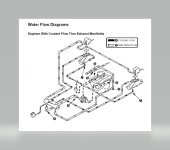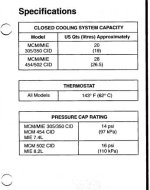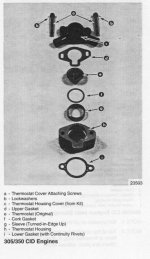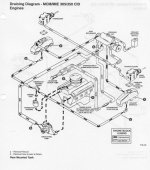anothercarguy
New member
Hi All, New to the forum, though I've lurked many times and have read a number of threads over the past few years.
Details: 1990 22' Searay Sundancer, 260hp, 5.7 Mercruiser (Quadrajet carburetor), 750 hours, good compression), Alpha 1 Gen 1 leg, freshwater cooled, antifreeze runs through the manifolds, sea water through the risers, boat operated in Pacific Northwest salt water.
Symptom: as RPM's increase (specifically between about 2500-3500) the temp rises from about 165-170 to close to 200. If I stop the boat, put into neutral but increase engine rpm, temp comes down to 165-170 ish.
Work/solutions done to date:
I'm a car guy with a pretty well equipped shop, I build hot rods as a hobby so I'm comfortable working on engines and mechanicals. I'm obviously missing something here. Any thoughts out there?
Details: 1990 22' Searay Sundancer, 260hp, 5.7 Mercruiser (Quadrajet carburetor), 750 hours, good compression), Alpha 1 Gen 1 leg, freshwater cooled, antifreeze runs through the manifolds, sea water through the risers, boat operated in Pacific Northwest salt water.
Symptom: as RPM's increase (specifically between about 2500-3500) the temp rises from about 165-170 to close to 200. If I stop the boat, put into neutral but increase engine rpm, temp comes down to 165-170 ish.
Work/solutions done to date:
- ohmed out temperature sensor - within spec, tested gauge - tests full scale and 0 scale as it should
- replaced impellor in leg
- after looking into leg further replaced leg with new Sterndrive Engineering leg (issue with leg was not related to overheating, but it does come with yet another new impellor)
- tested engine thermostat in pot of warming water- opened fully as it should
- replaced transom seals and hoses - confirmed that sea water hose is not crimped/restricted
- checked hose from transom to power steering cooler, hose clear
- power steering cooler clear
- flow checked seawater pick up per the manual (don't recall specific numbers as this was done last year, but water flow characteristics were within manual specs at set RPM)
- rodded out heat exchanger - clear
- replaced engine water pump
- inspected manifolds and risers a couple times, looked fine... replaced them anyway with new Mercruiser units
- pulled heads, checked head gaskets, rebuilt and re-installed
- carb rebuilt - runs well (not lean, if anything, the plugs are a bit sooty)
- checked for any obstructions in all hoses, all are clear
- used infrared thermometer around engine, temps are slightly lower than the gauge indicates, but are close enough that I would say the gauge is indicating what is going on.
I'm a car guy with a pretty well equipped shop, I build hot rods as a hobby so I'm comfortable working on engines and mechanicals. I'm obviously missing something here. Any thoughts out there?






